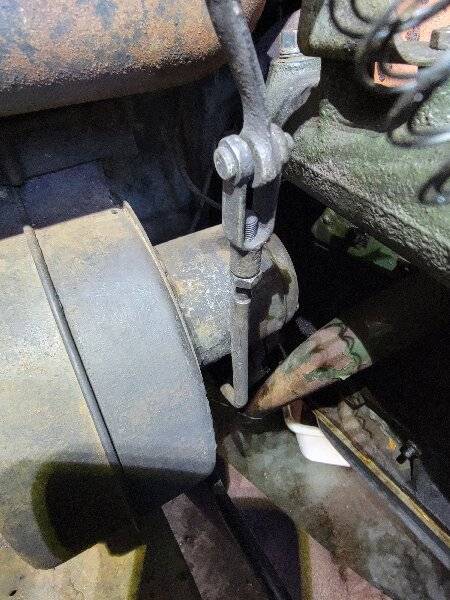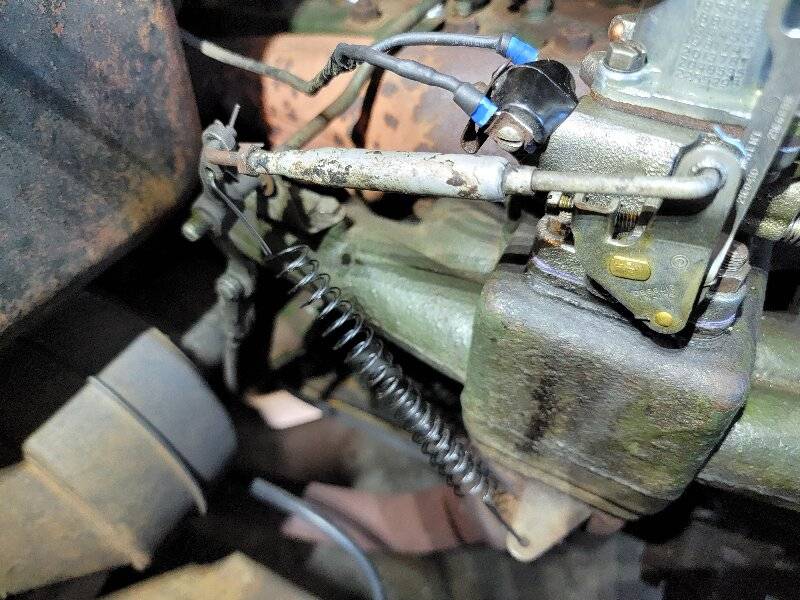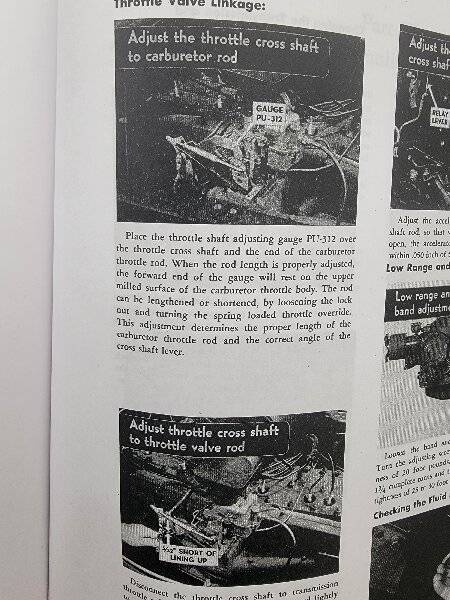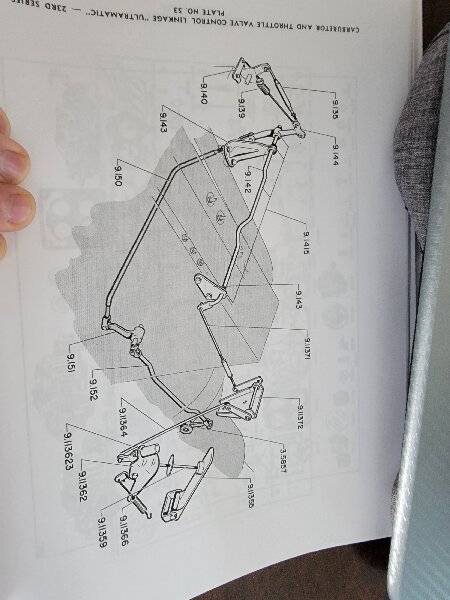|
Re: 1950 327 with Ultramatic - Idle Speed
|
||||
|---|---|---|---|---|
|
Forum Ambassador
|
Don't have an answer to why the idle is increasing so much but 650-700 is a bit too fast. Was the adjustment made when engine is warm and the carb fast idle is not in play? Is the linkage spring strong enough to move the linkage and close the throttle plate or could anything be interfering with the accelerator linkage? 49-50 Ultras with the two piece throttle valve linkage had a bellcrank on the side of the trans. That bellcrank did cause some drag issues if it started to stick and was eliminated in the 51s when Packard went to a one piece rod.
For what it's worth, the adjustment procedure you mentioned remained the same on all Ultramatic versions thru 56 but the recommended RPM varied from 375-400. Some have found the recommendation a bit low causing some engine stalls. You can increase it some -- but try to stay around 450 and not go above 500. If you go much higher than 500 the centrifugal advance in the distributor can start to interact and interfere with setting the timing as well as the car will want to creep excessively when stopped at a light.
Posted on: 2023/2/3 20:12
|
|||
|
Howard
|
||||
|
||||
|
Re: 1950 327 with Ultramatic - Idle Speed
|
||||
|---|---|---|---|---|
|
Home away from home
|
Thanks for this, Howard! I took the throttle body assembly apart tonight, found that the plates were definitely binding up. Loosened the screws on the plates and adjusted them so the throttle assembly moves freely. Other than that, nothing was noticeably off on the throttle body. I did also notice the cotterpin on the vacuum piston wasn't in the right place and causing the pin that holds the metering rods getting caught up on the anti-perc arm. Fixed that, too.
Still found myself in the (generally) same place, though. Basically, going into High cuts the engine speed in half. Or vice versa (engine speed doubles going into park). I know my timing is locked in. I'm going to try switching out my plugs for some fresh ones to take ignition out of the equation. Manifold vacuum is 20 hg in Park once the engine is warm (drops to around 15 in High); holds steady. Will chase the throttle valve linkage you were talking about tomorrow. Are there lube points to eliminate the possibility of sticking? Thanks again!
Posted on: 2023/2/4 1:16
|
|||
|
Joe B.
Greenville, NC 1950 Super Deluxe Eight Touring Sedan, Model 2302-5 327 w/ Ultramatic, 6v+ |
||||
|
||||
|
Re: 1950 327 with Ultramatic - Idle Speed
|
||||
|---|---|---|---|---|
|
Home away from home
|
I wonder if you aren't accidentally adjusting the idle speed in "Low" rather than "High". There will be more drag in low (or reverse) than High. The range selector order is different than a modern car.
Have you checked the fluid level in the Ultramatic? There is a procedure to do that. Have to run the car in neutral for a bit and then check with the engine is off, but just after you've turned it off. Easier if the car is up on ramps (best) or jackstands.
Posted on: 2023/2/4 1:48
|
|||
|
||||
|
Re: 1950 327 with Ultramatic - Idle Speed
|
||||
|---|---|---|---|---|
|
Home away from home
|
Hmm, I'm not sure to be honest. The Low gear (when I have it selected to Low that is) just acts as though it's in neutral. The High gear and Reverse do work. Is it possible my High selector is actually giving me Low?? Hadn't considered that. The car does cruise well at a variety of speeds - sort of just assumed I'd be pretty limited speed-wise in Low. I know all the bands can be adjusted - will try to see what everything is.
Been a couple weeks since I've checked the fluid, but I'll confirm it's still there (literally ever seal leaks, sigh).
Posted on: 2023/2/4 2:04
|
|||
|
Joe B.
Greenville, NC 1950 Super Deluxe Eight Touring Sedan, Model 2302-5 327 w/ Ultramatic, 6v+ |
||||
|
||||
|
Re: 1950 327 with Ultramatic - Idle Speed
|
||||
|---|---|---|---|---|
|
Home away from home
|
Actually, thinking about it, my statement doesn't really make sense. The output of the torque converter is stopped no matter in H, L, or R. So the drag to the engine should be the same.
Still, one thing I guess it could be would be a dragging or otherwise partially-engaged lockup clutch. When you drive around do you feel the torque converter lock up at, say, 25 mph or so? Forgive me, I'm thinking out loud here.
Posted on: 2023/2/4 2:48
|
|||
|
||||
|
Re: 1950 327 with Ultramatic - Idle Speed
|
||||
|---|---|---|---|---|
|
Home away from home
|
Well honestly, I don't think I've ever felt anything resembling a shift when driving. It just sort of feels like one gear, and that's it. I got to looking at the throttle linkage and comparing it against what's in the Ultramatic manual... something looks off to me, or at least setup looks different than what's in the manual. I've attached what my setup looks like and what's in the manual. Anything stick out to you?
Attach file:  20230204_134052.jpg (283.14 KB) 20230204_134052.jpg (283.14 KB)  20230204_134027.jpg (261.30 KB) 20230204_134027.jpg (261.30 KB)  20230204_092353.jpg (341.01 KB) 20230204_092353.jpg (341.01 KB)
Posted on: 2023/2/4 13:46
|
|||
|
Joe B.
Greenville, NC 1950 Super Deluxe Eight Touring Sedan, Model 2302-5 327 w/ Ultramatic, 6v+ |
||||
|
||||
|
Re: 1950 327 with Ultramatic - Idle Speed
|
||||
|---|---|---|---|---|
|
Home away from home
|
Found this diagram of the whole linkage setup. 9.144 - the lever, is it backwards??
Posted on: 2023/2/4 14:03
|
|||
|
Joe B.
Greenville, NC 1950 Super Deluxe Eight Touring Sedan, Model 2302-5 327 w/ Ultramatic, 6v+ |
||||
|
||||
|
Re: 1950 327 with Ultramatic - Idle Speed
|
||||
|---|---|---|---|---|
|
Forum Ambassador
|
Definitely get the linkage oriented properly and check how freely the bellcrank pivots on its shaft. There is nothing more critical in the Ultra operation than throttle linkage and its adjustment. Throttle pressure controls shifts and also modulates a valve that determins how much pressure is applied to lock the high range clutches together. Too low a pressure not squeezing the clutches together when a lot is needed and they can burn quite easily.
Quote: I don't think I've ever felt anything resembling a shift when driving. It just sort of feels like one gear, and that's it. This is correct. The Ultramatic is essentially a one gear transmission and that gear is selected by the operator when he puts the lever in high or low. The transmission starts and stays in the selected gear with the torque converter providing the extra assist a lower gear would provide in starting from a stop. It does this by multiplying torque there instead of the usual extra aid provided by a lower actual gear. Once the car has reached a constant speed of a few miles per hour, the components in the torque converter are essentially all rotating at the same rate so any farther torque multiplication is minimal. At that point the converter essentially becomes a fluid coupling. After all is steady and car is at a good driving speed the direct drive clutch is engaged and instead of the hard shift you would feel with a gear change, in a properly working Ultramatic about all that happens is maybe a slight sensation as the clutch is applied. The larger sensation is a sense of things being more calm and quiet as the engine RPM drops when power flow thru the torque converter (or fluid coupling) is no longer happening. If the direct drive clutch cork facing has become hard or worn there can be a shudder or even what is sometimes referred to as a "mooing" sound as the clutch engages. No harm will come from either but to minimize the sound and aid the shift into direct drive, letting off on the gas as the shift occurs is recommended. On the Ultramatics made thru 51 the clutch disc is approximately 11 inches in diameter and the piston is a large splined plate behind the clutch. The plates have been known to cock slightly and splines on the plate can catch in their mating groove and cause some issues. If the trans still has the original clutch it could be one that is hard and worn. With your description it does sound like the DD clutch is working though so unless there are other issues maybe just keep it in mind as there does not seem to be anything to be concerned about now. One thing that is very hard on the original Ultramatics is manually shifting from low to high under power. Because the trans was designed for a leisurely and smooth start many want a fast takeoff more like a stick shift or a modern car. They place the lever in low, start off at a light and then under power shift into high. This is to be avoided at all costs because there is no synchronization between gears in the original Ultras. As soon as the lever is moved, low will start to disengage, high will start to come in and there can be a period where both gears or neither gear is engaged. If both are engaged the engine and trans are essentially locked up and something mechanical can suffer and if neither are engaged the engine will race and then getting things under control again will all fall on the high range clutches. The extra friction trying to slow the engine puts a large strain on them and they facings can be burned in the process. If you must make the manual shift get it to speed then let off on the gas while you shift the lever and wait for the shift to complete before applying the gas again. Packard tried improving this issue with a timing kit but was not entirely successful. The redesigned 54 Gear start and later 55-6 TU's were the first Ultras that could more or less properly make an actual gear shift.
Posted on: 2023/2/4 14:42
|
|||
|
Howard
|
||||
|
||||
|
Re: 1950 327 with Ultramatic - Idle Speed
|
||||
|---|---|---|---|---|
|
Home away from home
|
I have a 1953 with a different linkage, so it's hard for me to tell whether this is right or not. The main thing here is at idle the lever at the transmission should not be forward, which would put pressure to engage the clutch. I guess to be sure, for the purpose of setting the idle, you could disconnect the linkage and make sure the lever is all the way to the rear at the transmission.
My only other thought, is that one wonders if your transmission has a different, more viscous, fluid in it than "Type F" which is the closest they make to what was originally used. That might make the torque converter "drag" greater. Do you feel a significant "clunk" when shifting at idle. That is a sign the idle speed is too high and/or the torque converter drag is for some reason greater than normal. Or again, it could simply be that, say, your fast idle isn't disengaging or something else at the carburator. Again, there are other folks who have more experience than myself in this matter.
Posted on: 2023/2/4 14:53
|
|||
|
||||









